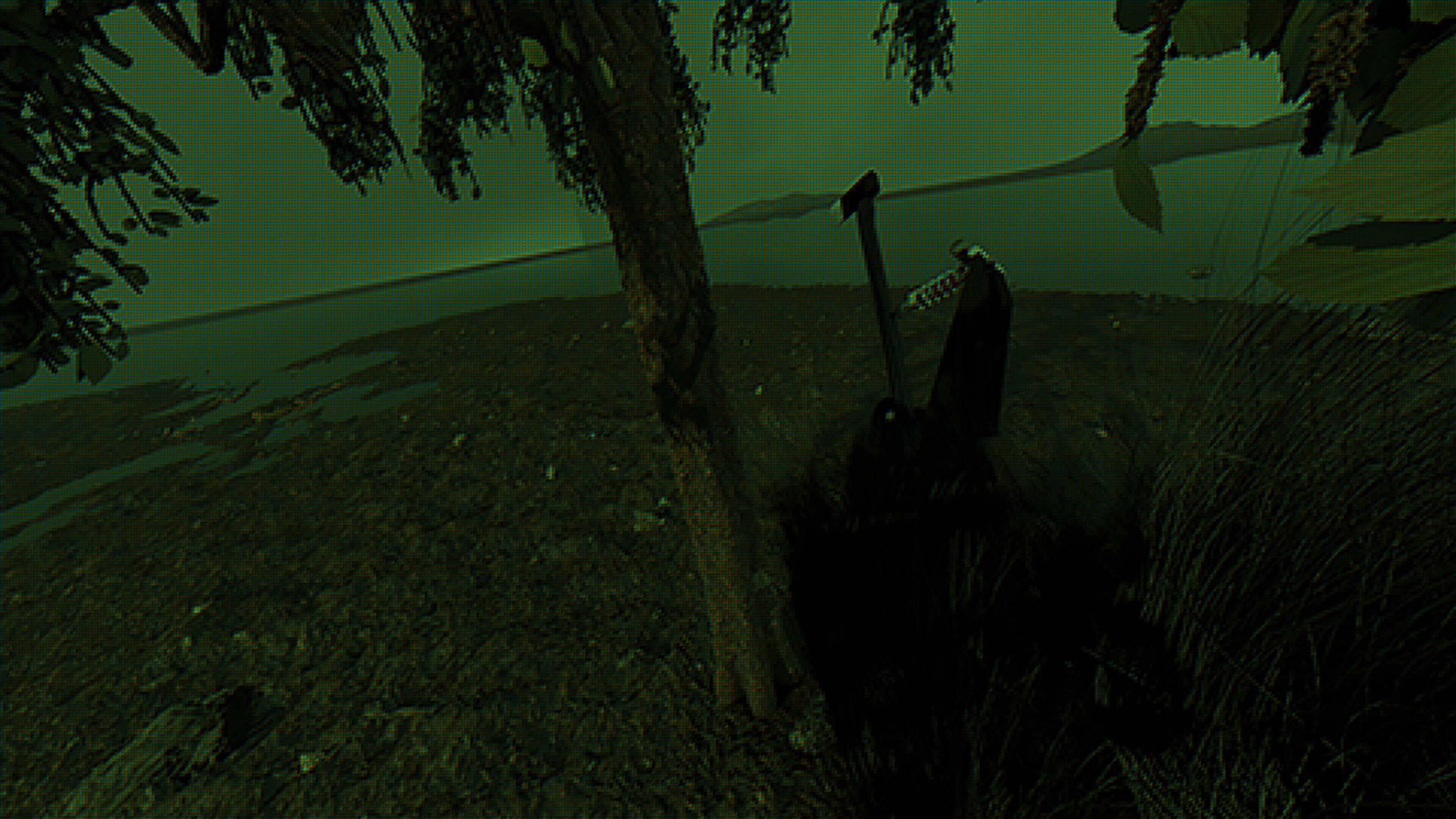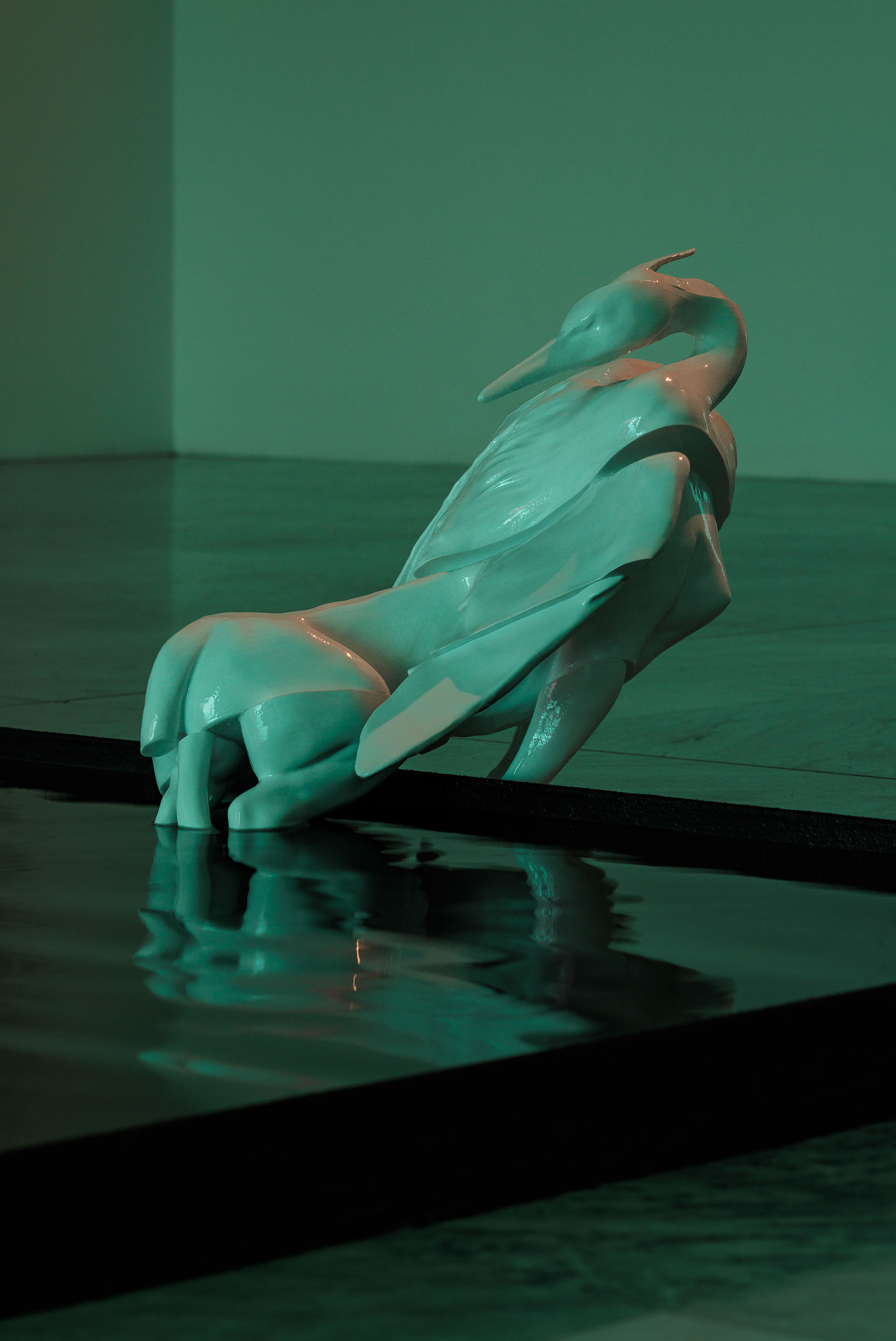YYYYMMDD >>> BACK HOME <<< >>> SELECTED FEATURES <<< >>> INTERVIEWS <<<
[20240510]
TERMINAL BEACH by TROIKA at MAK in the context of KLIMA BIENNALE WIEN 2024 curated by MARLIES WIRTH [from 20240501 to 20240811]
[Photos: kunst-dokumentation.com/MAK // Stills: Troika]













With the immersive spatial installation Terminal Beach, designed specifically for the MAK, the artist collective Troika unfolds a dystopian scenery at the edge of time, at the end of natural life on Earth, and the interface of the virtual and the material world. In the eponymous animation, a robot arm covered in black fur is chopping down the last tree on Earth while 3D-printed digital twins of museum objects—“Grenzgänger” (“crossers”)—populate a flooded landscape as enigmatic hybrid creatures. With this first solo exhibition in Austria, Troika focuses on the complex forms of non-human intelligence and raises questions regarding the adaptation of living beings to climate change as well as the digital afterlife of human myths, culture, and history.
“We are interested in exploring the idea of the liminal space, the space between the artificial and the natural, the living and the non-living, the ‘dematerialized’ digital world and our physical world, to create situations in which a kind of otherness can emerge,” Eva Rucki, Conny Freyer, and Sebastien Noel state. As the artist collective Troika, they have been exploring the manifold connections between humans, nature, and technology since 2003.
Troika unfolds an unsettling scene in the center of the MAK at Stubenring, in the MAK Contemporary exhibition space. The four-minute video Terminal Beach (2020), played in a loop on a giant LED-wall makes the suffering of the last tree seem endless. Unceasingly, in an ever same rhythm, the robot chops at the trunk of the tree with an axe. Each strike lets the tree tremble to its core. The scene is set in a deserted landscape where all natural life has perished.
Visitors experience the action from various perspectives: from the cinematic eye of the camera, the vigilant eye of a drone, the point of view of the perpetrator themself, and—in the last sequence—the perspective of the tree, which perceives the events from within. The loop suspends the seemingly inevitable conclusion, inviting reflections on alternate endings.
The uncanny impression of the robot arm is enhanced by an acoustic setting reminiscent of birdsong. In fact, it is a geophony of radio waves generated by lightning strikes and geomagnetic storms, which was recorded by the British Antarctic Survey as radio waves.
The cinematic plot is continued in the real exhibition space. The barren land, the distant sky, a beach, and water emerge from the LED-screen into the here and now and are reflected in a water basin. The colors of the film also spill into reality and bathe the room in different shades of light.
In the flooded, color-saturated landscape emerges a gathering of several sculptures—strange creatures that seem to be fleeing from the long-gone forest: digital afterlives, ghosts of human myths, born from recombinant digital bits. Thus, the artist group expands the idea of liminality—a state of transition—in the environment with three-dimensional collages, drawing on mythical representations of “crossers” who watch over thresholds, gates, or borders: fauns, sphinxes, phoenixes, and centaurs.
The “crossers” follow a series of sculptures for which the collective draws from its archive of digitized objects from museum collections—fragments of the digital twins of historical objects are re-combined to new figures and 3D-printed.
For Heron Sphinx, selected objects from the MAK Collection were 3D-scanned for the wax model of a sphinx (deformed by heat), the so-called “zero pattern” for a casting mold for porcelain production from the archive of the Imperial Royal Vienna Porcelain Manufactory (18th c.), and the bronze cast of a heron with a rhinoceros beetle (Japan, 19th c.), from the golden age of Japonism, a period in which bronze figures with nature motifs were exported to Europe and the USA.
The title of the exhibition and video refers to J.G. Ballard’s collection of science fiction short stories The Terminal Beach (1964). They revolve around the bitter paradox of the extraordinary creative power of human imagination that seems to be only surpassed by its reckless destructive drive. The constructed landscape, or “second nature,” is discussed as a sphere created—and then again destroyed—by humans themselves.
About Troika:
The German-French artist group Troika was founded in 2003 by Eva Rucki (* 1976, Germany), Conny Freyer (* 1976, Germany), and Sebastien Noel (* 1977, France), and is based in London. In their cross-media works in the fields of sculpture, film, installation, and painting, they process the experiences and attitudes of humanity with regard to new technologies as well as how these change our relationships to nature, to each other, and to the world in general.
Troika explores systems of knowledge in the fields of philosophy of nature and history of technology and delves into topics such as artificial intelligence, algorithmic data, non-human forms of life, or virtual and physical systems of representation.
Troika’s works are a part of the permanent collections of the M+, Hong Kong, the Victoria & Albert Museum, London, the Art Institute of Chicago, the MoMA, New York, the Fundación Jumex, Mexico City, the Israel Museum, Jerusalem, and the Centre Pompidou, Paris.
[Text: Marlies Wirth / MAK]
©YYYYMMDD All content and design by Daniela Grabosch + Ricardo Almeida Roque unless otherwise stated. Images, Videos and Texts can only be used under permission of the author(s).